Spinal Cord Stimulation Devices Market Research, 2032
The global spinal cord stimulation devices market size was valued at $2.1 billion in 2022, and is projected to reach $4.8 billion by 2032, growing at a CAGR of 8.4% from 2023 to 2032.
Spinal cord stimulation device is a type of medical device used to treat chronic pain by sending electrical impulses to the spinal cord. The device consists of a small electrical generator, a wire that is inserted into the spinal canal, and electrodes that are placed near the spinal cord. The generator is implanted under the skin, while the electrodes are placed in the epidural space near the spinal cord. The electrical impulses sent by the device interfere with the transmission of pain signals to the brain, providing relief for patients with chronic pain conditions such as failed back surgery syndrome, complex regional pain syndrome, and neuropathic pain.
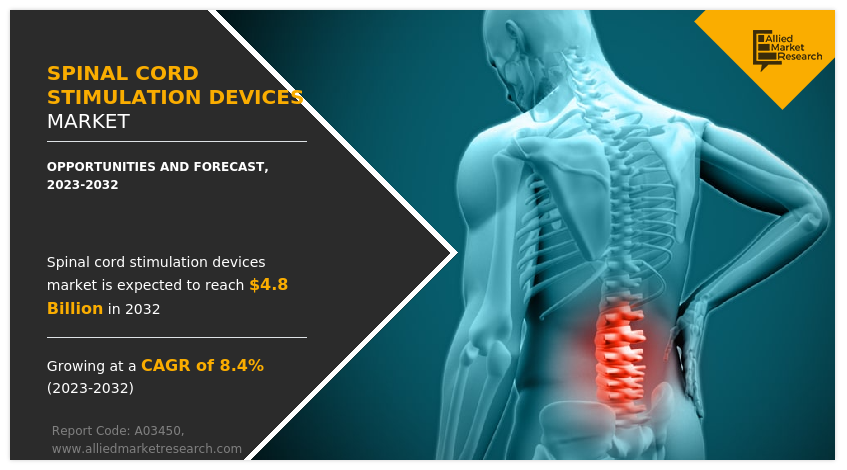
Market dynamics
The major factors driving the spinal cord stimulation devices market growth are increase in prevalence of chronic pain, surge in aging population, technological advancements, and rise in awareness about spinal cord stimulation devices. Chronic pain is a common condition that affects millions of people worldwide. For instance, according to the World Health Organization (WHO) 2021, chronic pain affects 20% of the world's population. Thus, rise in prevalence of chronic pain is driving the demand for spinal cord stimulation devices as they serve as an effective treatment for this condition.
Further, aging population is increasing globally, which is driving the demand for spinal cord stimulation devices. As people age, they are more likely to develop chronic pain and other conditions that require the use of spinal cord stimulation devices. In addition, aging can lead to degenerative changes in the spine, which can cause chronic pain and other spinal conditions.
Moreover, technological advancements in spinal cord stimulation devices are driving the growth of the market. New devices are being developed with advanced features such as wireless connectivity, longer battery life, and improved programming. These advancements are improving patient outcomes and increasing the adoption of spinal cord stimulation devices. Innovations in the medical device industry to launch advanced spinal cord stimulation devices to cater to the unmet medical needs of massive pool of target population are expected to create lucrative opportunities for the expansion of the spinal cord stimulation devices market.
Further, increase in awareness of spinal cord stimulation devices among patients and healthcare providers is expected to propel the market. Patients are becoming more aware of the benefits of these devices, and healthcare providers are recommending them as a viable treatment option for chronic pain and other spinal conditions. In addition, availability of favorable reimbursement policies is boosting the growth of the spinal cord stimulation devices market. Many governments and insurance companies are providing reimbursement for spinal cord stimulation devices, making them more affordable for patients. This is increasing the adoption of these devices and driving the growth of the market.
The spinal cord stimulation devices market forecast is expected to be driven by emerging markets, owing to availability of improved healthcare infrastructure, increase in unmet healthcare needs, rise in prevalence of chronic pain conditions such as degenerative disc disease (DDD), and diabetic neuropathy. Furthermore, the healthcare industry in emerging economies is developing at a significant rate, owing to rise in demand for enhanced healthcare services, significant investments by government to improve healthcare infrastructure, and development of the medical tourism industry in emerging countries. Moreover, governments in many countries are investing in healthcare infrastructure and promoting the adoption of spinal cord stimulation devices, which drives the market.
The spinal cord stimulation devices market opportunity is not only limited to developed countries but is also being witnessed in the developing countries, such as China, Brazil, and India, which fuels the growth of the market. Factors such as rise in adoption of spinal cord stimulation devices, increase in awareness about chronic pain management, and surge in investments for development spinal cord stimulation devices further drive the growth of the market.
However, spinal cord stimulation devices are relatively expensive, which may limit their adoption among patients who cannot afford them or healthcare systems with limited budgets. Further, as with any surgical procedure, there is a risk of complications associated with the implantation of spinal cord stimulation devices. These complications can include infection, bleeding, and nerve damage.
The outbreak of COVID-19 has disrupted workflows in the healthcare sector around the world. The COVID-19 pandemic has had a significant impact on the healthcare industry, including the spinal cord stimulation devices market. Many hospitals and clinics postponed elective surgeries during the pandemic to free up resources for COVID-19 patients. This led to a decrease in the number of spinal cord stimulation device implantations, as these procedures are often elective. The pandemic led to reduction in patient visits to healthcare facilities owing to fear of infection or restrictions on non-essential services. This resulted in a decrease in the number of patients seeking spinal cord stimulation devices for chronic pain or other spinal conditions. Thus, COVID-19 negatively impacted the growth of the spinal cord stimulation devices market.
Segmental Overview
The spinal cord stimulation devices market size is segmented into product, indication, end user, and region. On the basis of product, the market is categorized into rechargeable devices and non-rechargeable devices. By indication, the market is segergated into failed back surgery syndrome, complex regional pain syndrome, degenerative disc disease, and others. Depending on end user, it is fragmented into hospital, ambulatory surgical centers, and others. Region wise, the market is analyzed across North America (the U.S., Canada, and Mexico), Europe (Germany, France, the UK, Italy, Spain, and rest of Europe), Asia-Pacific (Japan, China, Australia, India, South Korea, and rest of Asia-Pacific), and LAMEA (Latin America, and Middle East Africa).
By Product
On the basis of product, the rechargeable devices segment accounted for largest spinal cord stimulation devices market share in 2022 and is expected to register highest CAGR during the forecast period owing to several advantages they offer over non-rechargeable devices. Rechargeable devices offer longer battery life and greater flexibility in programming and adjusting the stimulation settings according to the patient’s needs. In addition, rechargeable devices have smaller and more compact battery designs, which make them less bulky and more comfortable for patients to wear.
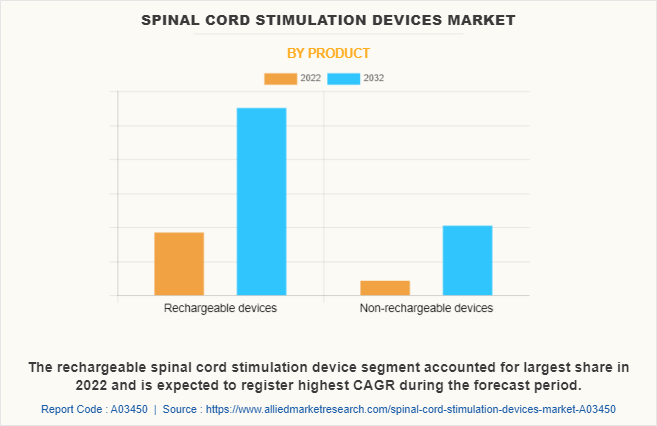
By Indication
Depending on indication, the failed back surgery syndrome accounted for largest spinal cord stimulation devices market share in terms of revenue in 2022, owing to rise in number of spinal surgeries and increase in adoption of spinal cord stimulation therapy as it has proven to be effective in treating failed back surgery syndrome. The degenerative disk disease segment is anticipated to register highest CAGR during the forecast period owing to increase in number of patients suffering from degenerative disk disease and rise in adoption of spinal cord stimulation therapy to provide long-term pain relief.
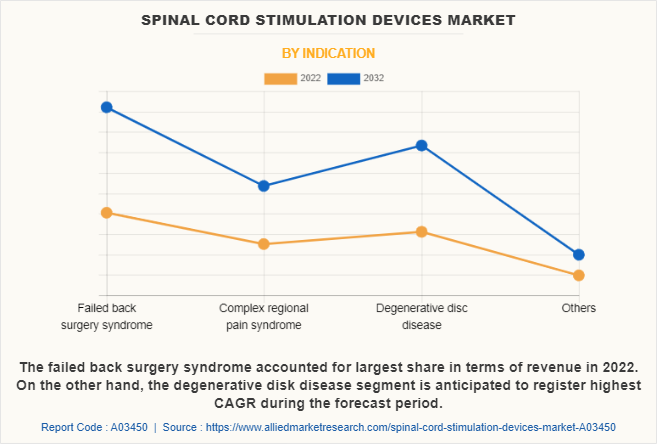
By End User
By end user, the hospitals segment accounted for largest share in terms of revenue in 2022, and is anticipated to register highest CAGR during the forecast period owing to availability & access to specialized healthcare professionals, advanced medical technologies & infrastructure, and strong relationships with insurance providers resulting in adoption of spinal cord stimulation therapy.
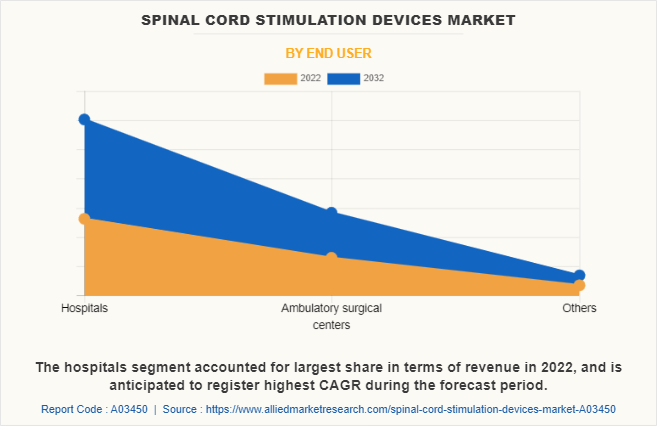
By Region
North America accounted for the largest share in terms of revenue in 2022 owing to high prevalence of chronic pain conditions, availability of advanced healthcare facilities, and presence of major players offering spinal cord stimulation devices. In addition, favorable reimbursement policies in healthcare systems and rise in geriatric population are expected to propel the market expansion. However, Asia-Pacific is anticipated to witness notable growth, owing to rise in number of chronic pain conditions, increase in awareness regarding available spinal cord stimulation treatment devices, and surge in investments for development of effective spinal cord stimulation devices for chronic pain. Upsurge in healthcare expenditure in the emerging economies is anticipated to offer lucrative opportunities for the market expansion.
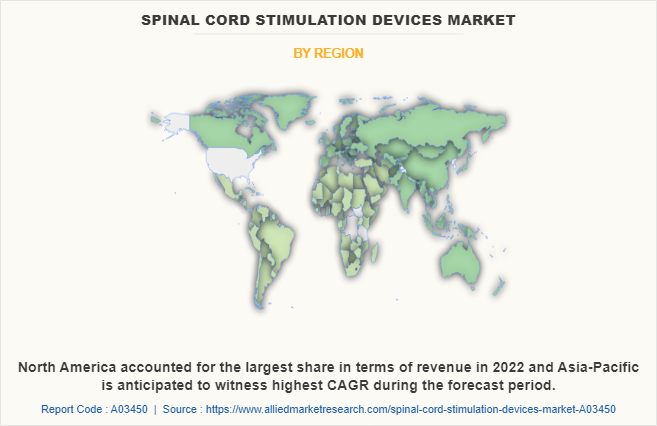
Asia-Pacific is expected to grow at the highest rate during the forecast period owing to technological advancements, increase in prevalence of chronic pain disorders such as chronic back pain, rise in demand for advanced spinal cord stimulation devices, surge in investment in healthcare infrastructure, growth in geriatric population, and favorable government initiatives toward use of spinal cord stimulation devices for chronic pain management. Moreover, the region has become a hub for spinal cord stimulation devices market owing to its large population base, diverse patient pool, and relatively lower costs of spinal cord stimulation implant surgery compared to developed countries.
Furthermore, high prevalence of chronic pain conditions, such as failed back surgery syndrome (FBBS), complex regional pain syndrome (CRPS), painful diabetic neuropathy (PDN), is driving the demand for spinal cord stimulation devices. Moreover, rise in research activities as well as well-established presence of domestic companies in the region are expected to provide notable opportunities for the market growth. In addition, rise in contract manufacturing organizations within the region is expected to open new avenues for the spinal cord stimulation devices industry.
Competition Analysis
Competitive analysis and profiles of the major players in the spinal cord stimulation devices market such as Medtronic plc, Boston Scientific Corporation, Abbott Laboratories, Nevro Corporation, Beijing PINS Medical Co., Ltd, Saluda Medical Pty Ltd., Nalu Medical, Inc., BIOTRONIK, GIMER MEDICAL, and Teliatry, Inc. are provided in this report. Major players have adopted acquisition, product launch, product approval, and expansion as key developmental strategies to strengthen their foothold in the spinal cord stimulation devices industry.
Recent Product Approval in Spinal Cord Stimulation Devices Market
In January 2022, Medtronic Plc, a global leader in healthcare technology, announced it has received U.S. Food and Drug Administration approval of its Intellis rechargeable neurostimulator and Vanta recharge-free neurostimulator for the treatment of chronic pain associated with diabetic peripheral neuropathy (DPN).
Recent Product Launch in Spinal Cord Stimulation Devices Market
In January 2021, Boston Scientific announced a limited market release of the WaveWriter Alpha portfolio of Spinal Cord Stimulator (SCS) systems. The unified portfolio of four MRI conditional, Bluetooth-enabled rechargeable and non-rechargeable implantable pulse generators (IPGs) provides uncompromised personalization, and for the first time in SCS, Fast Acting Sub-Perception Therapy (FAST) designed to deliver profound paresthesia-free pain relief in minutes.
Recent Acquisition in Spinal Cord Stimulation Devices Market
In January 2020, Medtronic plc announced it has acquired Stimgenics, LLC, a privately held company based in Bloomington, Illinois, that has pioneered a novel spinal cord stimulation (waveform known as Differential Target Multiplexed (DTM™) Spinal Cord Stimulation.
Recent Expansion in Spinal Cord Stimulation Devices Market
In October 2022, Nevro Corp., a global medical device company that is delivering comprehensive, life-changing solutions for the treatment of chronic pain, announced that the U.S. Food and Drug Administration (FDA) expanded its manufacturing operations in Costa Rica for the production of its proprietary spinal cord stimulation systems for the treatment of chronic pain, including its HFX product platform.
Key Benefits For Stakeholders
- This report provides a quantitative analysis of the market segments, current trends, estimations, and dynamics of the spinal cord stimulation devices market analysis from 2022 to 2032 to identify the prevailing spinal cord stimulation devices market opportunities.
- The market research is offered along with information related to key drivers, restraints, and opportunities.
- Porter's five forces analysis highlights the potency of buyers and suppliers to enable stakeholders make profit-oriented business decisions and strengthen their supplier-buyer network.
- In-depth analysis of the spinal cord stimulation devices market segmentation assists to determine the prevailing market opportunities.
- Major countries in each region are mapped according to their revenue contribution to the global market.
- Market player positioning facilitates benchmarking and provides a clear understanding of the present position of the market players.
- The report includes the analysis of the regional as well as global spinal cord stimulation devices market trends, key players, market segments, application areas, and market growth strategies.
Spinal Cord Stimulation Devices Market Report Highlights
| Aspects | Details |
| Market Size By 2032 | USD 4.8 billion |
| Growth Rate | CAGR of 8.4% |
| Forecast period | 2022 - 2032 |
| Report Pages | 258 |
| By Indication |
|
| By Product |
|
| By End User |
|
| By Region |
|
| Key Market Players | Saluda Medical Pty Ltd., Boston Scientific Corporation, Teliatry, Inc., Beijing PINS Medical Co., Ltd, Nalu Medical, Inc., BIOTRONIK SE & Co. KG, GIMER MEDICAL, Medtronic plc, Abbott Laboratories, Nevro Corporation |
Analyst Review
This section provides various opinions in the global spinal cord stimulation devices market. The spinal cord stimulation devices market is expected to exhibit high growth potential owing to increase in demand for advanced spinal cord stimulation device and rise in investments for research and development activities related to chronic pain management globally are expected to offer profitable opportunities for the expansion of the market. In addition, favorable government initiatives and reimbursement schemes for chronic pain management have piqued the interest of several companies to develop advanced spinal cord stimulation devices.
Further added that rise in expenditure on the development of healthcare infrastructure and surge in geriatric population are expected to boost the growth of spinal cord stimulation devices market. In addition, increase in burden of chronic pain conditions across the globe has resulted in rise in demand for spinal cord stimulation devices, thus driving the growth of market.
North America accounted for the largest share in terms of revenue in 2022 owing to high prevalence of chronic pain conditions, availability of reimbursement policies, and presence of major players offering spinal cord stimulation devices. However, Asia-Pacific is anticipated to witness notable growth, owing to rise in number of chronic pain conditions, increase in awareness regarding available spinal cord stimulation treatment devices, and surge in investments for development of effective spinal cord stimulation devices for chronic pain.
The total market value of spinal cord stimulation devices market is $2,126.84 million in 2022.
The forecast period for spinal cord stimulation devices market is 2023 to 2032.
The market value of spinal cord stimulation devices market in 2032 is $4,777.79 million.
The base year is 2022 in spinal cord stimulation devices market.
Top companies such as, Medtronic Plc, Boston Scientific Corporation, Abbott Laboratories, and Nevro Corporation held a high market position in 2022. These key players held a high market position owing to the strong geographical foothold in North America, Europe, Asia-Pacific, and LAMEA.
The rechargeable spinal cord stimulation device segment is the most influencing segment in spinal cord stimulation devices market owing to several advantages they offer over non-rechargeable devices such as longer battery life and higher flexibility in programming and adjusting the stimulation settings according to the patient’s needs.
The major factor that fuels the growth of the spinal cord stimulation devices market are surge in technological advancements in spinal cord stimulation devices, rise in prevalence of spinal disorders, and availability of medical reimbursements for spinal cord stimulation procedure.
Spinal cord stimulation is a medical technique that involves the use of an implanted device that delivers electrical impulses to spinal cord, with the aim of reducing pain and improving function in patients with chronic pain conditions.
Spinal cord stimulation devices are used to treat a variety of conditions, such as failed back surgery syndrome (FBSS), complex regional pain syndrome (CRPS), degenerative disc disease (DDD), and painful diabetic neuropathy (PDN).
Loading Table Of Content...
Loading Research Methodology...



